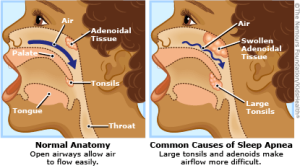Snoring and Apnoea in Children
Snoring describes noisy breathing during sleep. Apnoea means pausing in breathing during sleep. Many children will snore if they have a cold or blocked nose and this is common and expected to resolve. However some children, even as young as 18 months will constantly snore and may have apnoea. This article is aimed helping to decide how serious this is. If there is significant sleep apnoea (pausing in breathing noted due to obstruction) then sometimes intervention is needed.
What Causes Snoring ?

Our upper airways consist of the nasal passages, the mouth and the airways of the throat or pharynx. During sleep, these airways are relaxed which can make them smaller. Air being transferred across a narrow passage will become noisy. If there is a partial blockage of these airways the noise can be particularly loud. Some children will snore constantly, and this will affect their quality of sleep. One of the most common reasons is the presence of enlarged tonsils and adenoids which are partially obstructing the flow of air. A second cause of snoring is related to blocked nasal passages which can sometimes be due to allergies. This is termed allergic rhinitis or hay fever.
What are Tonsils and Adenoids?
Tonsils and adenoids are lumps of fleshy tissue that are basically lymph nodes. The body has hundreds of lymph nodes that are scattered throughout and they are part of the immune system. Sometimes when faced with recurrent viruses these lymph nodes swell to a size that can partially block the upper airways. The adenoids live behind the nostrils and the tonsils live at the back of the throat. (see diagram above)
What about tonsillitis ?
This is a name given for infection of the tonsils which causes them to be enlarged and sometimes appear red and inflamed. For more information see tonsillitis. Recurrent tonsillitis can occasionally be severe enough to warrant removal, and can also contribute to large obstructing tonsils.
How Bad is snoring ?
Temporary snoring is common. However persistent snoring and apnoea, which occurs in up to 5% of children can result in a number of problems that adversely affect sleep quality, resulting in overtiredness and impaired quality of life. Snoring in childhood can be divided into one of the following groups
- Mild – Occasional snorer – mainly with colds but when well has no breathing issues – wait and see approach needed here.
- Moderate snorer – nighttime noisy breathing, with increased effort noted with breathing, but and occasional apnoea episodes.
- Severe – Obstructive Sleep Apnoea – this is where there are pauses in breathing due to the extent of the obstruction in the airways. This child will snore loudly, pause and then appear to gasp as the body recognises a need to ‘get some air’. There will be considerable effort required to breath, which is recognised by sucking in of the chest.
My Child Snores. How Can I tell if it is significant ?

Generally if the snoring and apnoea is persistent (6months or more) and results in symptoms suggestive of interrupted sleep and increased work of breathing, then he should be assessed by a suitably qualified ENT surgeon.
During Sleep – observe and even video the following:
- Snoring – nightly, persistent and constant
- Apnoea – nightly and frequent
- Choking noises and gasping
- Concerns your child is not getting enough air
- Neck is arched back during sleep (to keep the airway as open as possible)
During the day watch out for
- Difficulty eating breakfast and lumpy foods (suggestive of large swollen tonsils)
- Exhaustion leading to irritability and hyperactivity
- Sleepiness
- Difficulty in school – behaviour and grades.
Other health issues related to disordered night time breathing
- Strain on the heart
- Facial structural changes
- Chest wall changes
- Poor growth
- Bedwetting
How to get help
The above symptoms indicate your child requires an assessment by an ENT department, either privately or in the public sector. Obtain a referral from you GP and ensure the above symptoms are listed, which will help your child to be seen sooner, particularly in the public system where long waits can occur.




